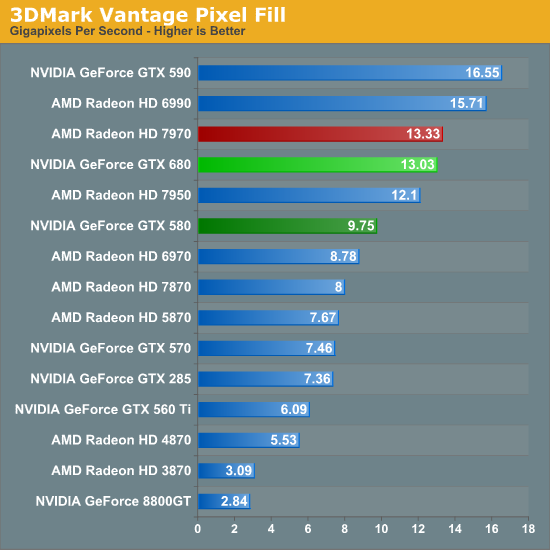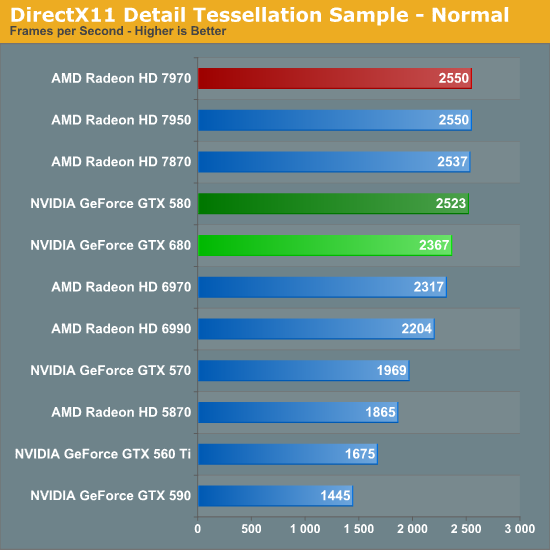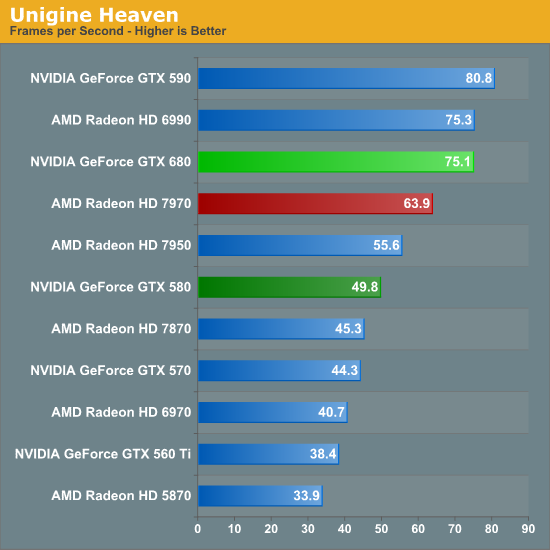NVIDIA GeForce GTX 680 Review: Retaking The Performance Crown
by Ryan Smith on March 22, 2012 9:00 AM ESTTheoreticals
As with any new architecture, we want to take a few moments to look at theoretical performance. These numbers shouldn’t be taken too seriously for cross-vendor comparison, but these numbers often tell us more about interesting architectural improvements that occur from one generation to the next.

Our first theoretical test is perhaps the most perplexing: 3DMark Vantage’s pixel fill test. Typically this test is memory bandwidth bound as the nature of the test has the ROPs pushing as many pixels as possible with as little overhead as possible, which in turn shifts the bottleneck to a mix of ROP performance and the memory bandwidth needed to feed those ROPs.
Compared to the GTX 580, the GTX 680 has almost exactly the same amount of memory bandwidth (192GB/sec) and only 86% of the theoretical ROP performance (37Gpix vs. 32Gpix). In short, it shouldn’t outperform the GTX 580 here, and yet it outperforms the 580 by 33%.
Why does it do this? That’s the hard thing to answer. As we mentioned in our look at GK104’s architecture, NVIDIA did make some minor incremental improvements to their ROPs coming from GF114, such as slightly improved compression and improved polygon merging. One of those may very well be the contributing factor, particularly the compression improvements since this is a typically memory bandwidth bottlenecked test. Alternatively, it’s interesting to note that the difference between the two video cards is almost identical to the difference in the core clock. GTX 560 Ti’s results tend to blow a hole in this theory, but it bears consideration.
In any case, it’s an interesting turn of events and hopefully one that isn’t simply an edge case. As we’ve seen in our benchmarks GTX 680 has strong performance – even if its lead compared to the 7970 diminishes with resolution – but compared to the GTX 580 in particular it needs strong ROP performance across all games in order to deliver good performance at high resolutions and anti-aliasing.

Our second theoretical test is 3DMark Vantage’s texture fill test, which to no surprise has the GTX 680 handily clobbering all prior NVIDIA cards. NVIDIA’s inclusion of 128 texture units on GK104 versus 64 on their previous generation GPUs gives the GTX 680 far better texturing performance. The 30%+ core clock difference only serves to further widen the gap.


Our third theoretical test is the set of settings we use with Microsoft’s Detail Tessellation sample program out of the DX11 SDK. Overall while NVIDIA didn’t make any significant changes to their tessellation hardware (peak triangle rate is still 4/cycle), they have been working on further improving performance at absurdly high tessellation factors. You can see some of this in action at the max factor setting, but even then we’re running into a general performance wall since the Detail Tessellation program can’t go to the absolute highest tessellation factors NVIDIA’s hardware supports.

Our final theoretical test is Unigine Heaven 2.5, a benchmark that straddles the line between a synthetic benchmark and a real-world benchmark as the engine is licensed but no notable DX11 games have been produced using it yet. In any case the Heaven benchmark is notable for its heavy use of tessellation, which means it’s largely a proxy test for tessellation performance. Here we can see the GTX 680 shoot well ahead of the GTX 580 – by more than we saw in the DX11 Detail Tessellation sample – but at the same time there’s a lot more going on in Heaven than just tessellation.
Honestly at this point in time I’m not sure just how much more tessellation performance is going to matter. Until DX11 is the baseline API for games, tessellation is still an add-on feature, which means it’s being used to add fine detail to specific models rather than being used on everything in a game world. This demands good tessellation at high factors but at the same time it’s subject to diminishing returns on the improvement to image quality as triangles reach single pixel sizes and smaller. To that end I’m still waiting to see the day where we see tessellation scale similarly to textures – that is by using full MIP chaining of displacement maps – at which point we can evaluate tessellation performance similar to texture performance when it comes to both measuring the performance hit and evaluating the difference in image quality.










404 Comments
View All Comments
CeriseCogburn - Tuesday, March 27, 2012 - link
What you're saying is true for amd cards, and is severe in CF, but true across the board.Lower clocked cpu system, better results from Nvidia.
bozolino - Monday, March 26, 2012 - link
I dont know whats happening. I have a gtx 560 2win and wanted to compare it to the 680 and see if its worth the replace but the charts cant be compared, for example:http://www.anandtech.com/show/5048/evgas-geforce-g...
This review uses an i7 3xxx while the older uses an i7 720, how can the older cpu performs better than the new one?? Something is very odd....
I wish they had used same computer as vga test bench, so we could compare all the results together....
Sharpie - Monday, March 26, 2012 - link
Its about design trade offs, you can increase the memory speed if you have a narrow bus to get the same throughput of something with lower clock speed and a large bus. all depeends on the architectural design so arguing about clock numbers is pointless generally speaking unless you are comparing apples to apples. Comapring an NVidia chip to an ATI chip is apples to oranges. Yes, im an engineer.CeriseCogburn - Tuesday, March 27, 2012 - link
Oh I get it you're in some pretend world where the card companies are not "fanboy compared" in the article itself.Once the amd card loses, and someone tells the truth about that, it's trolling or fanboy right ?
If an amd fan lies, it's "a good opinion".
If an amd fan liar gets corrected, that's "taking it too far" into "fanboy".
Once aghain, telling the truth on the two competing cards is forbidden only if it's an Nvidia advantage - then WE MUST OMIT the AMD card from the analysis, right ?
I think you might as well NEVER read another article on a card launch at this site, if you intend to stick to your RUDE comment.
CeriseCogburn - Tuesday, March 27, 2012 - link
Heck you didn't read this article nor many others then that say and prove the exact thing.I'm sure it will never make sense to you.
SlyNine - Friday, April 27, 2012 - link
Actually, I'm pretty sure it's you that doesn't understand the DX API. The CPU's are doing roughly the same thing for both videocards. Cept when it comes to processing the Drivers.CeriseCogburn - Tuesday, March 27, 2012 - link
The GTX690 currently holds the world record with a 1,900mhz overclock, and is gaining easily 15% with noob out of box overlclocks, and reaching very high memory clocks as well as 1,300+ core, I've seen 1,420 on air, and overclocked models are on their way....So much for that fud about 7970... it's FUD FUD and pure FUD.
blanarahul - Tuesday, March 27, 2012 - link
GTX 690????blanarahul - Tuesday, March 27, 2012 - link
Smart move by NVIDIA. Make a single gpu powerful graphics card to battle the Dual Tahiti monster. Judging by how they are doing the GTX 680 it should have the following specs:-4.72 billion transiostors
2048 CUDA Cores
384-bit memory bus width
3 GB VRAM
600-700 USD
TDP of 225-250W
If the clock speeds high enough, it will be quite a match for the 7990!
The reason i think it will be a single GPU card is because GTX 680=2x GTX 560 Ti.
So it should be GTX 690=2x GTX 580.
CeriseCogburn - Tuesday, March 27, 2012 - link
The release date of the 7970 was jan 11th, 2.5 months is opverstating in AMD's favor...Nothing like not knowing what you're talking about huh.
7970's have come down in price a bit, but you still will find them for much more than $569 at an awful lot of USA online places.